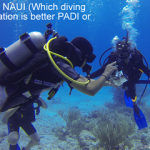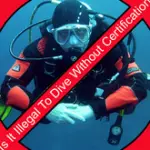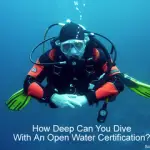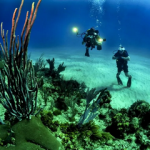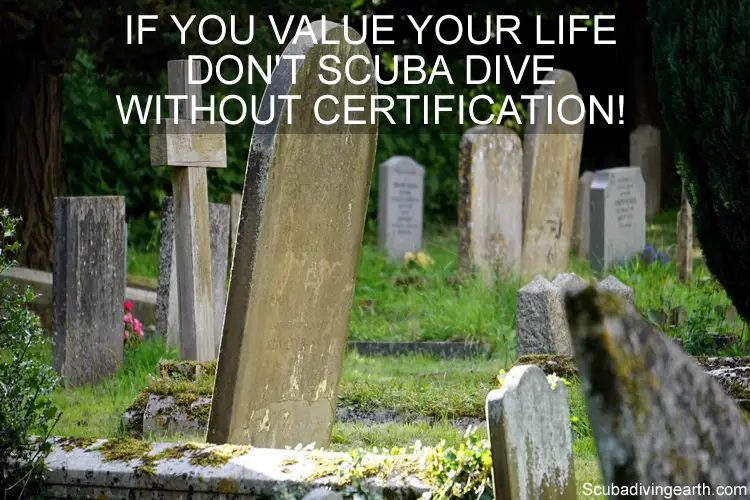
How to scuba dive without certification; Don’t even consider it. Get qualified and be safe.
If you’ve landed on this page having asked the question “How to scuba dive without certification?” I urge you to read this whole article. This actually scared me to learn that people ask this question.
How To Scuba Dive Without Certification? Never scuba dive without certification unless you’re with a scuba diving instructor teaching to dive. Without a scuba certification you won’t understand the risks involved with scuba diving until you’ve gone through the training. If you value your life simply don’t dive without being certified.
“Having rescued scuba divers whilst scuba diving, I understand the importance of being certified to scuba dive. Scuba diving is a dangerous sport, as you are in an unnatural environment, breathing air from an aqualung and experiencing pressure at depth, where mistakes underwater cost lives.“
The best way to dive anywhere in the world is by a scuba diving liveaboard. You can check the latest and best deals on liveaboards using the following window (opens in a new window):
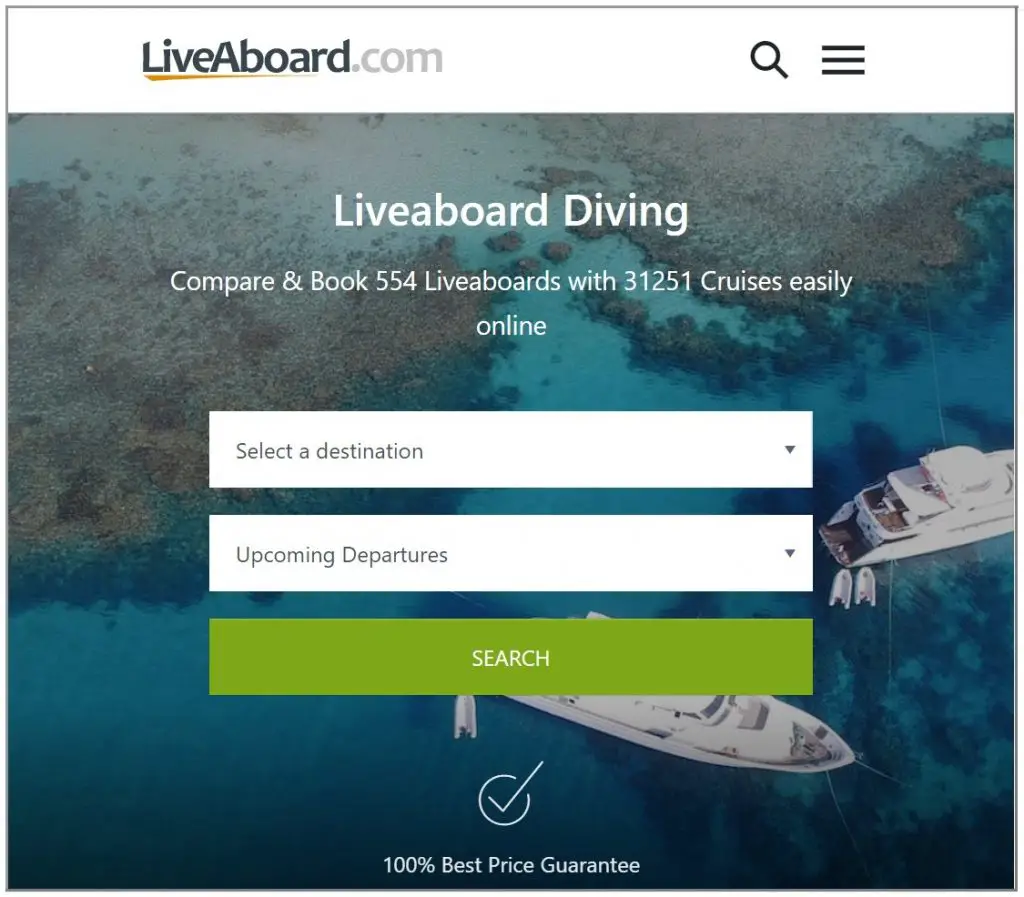
Or search our dive liveaboard pages here:
Scuba diving is a dangerous sport
Even qualified divers have died scuba diving. Some of these have years of experience and thousands of dives under their belt.
Consider if you have a family. The risks are huge to those that don’t know what they are doing.
I want to emphasise that I am not looking to put anyone off from scuba diving. But it’s important to highlight that all of these risks and dangers associated with scuba diving are minimised through proper training and experience.
I actively encourage people to join in the sport. It’s such a fantastic sport and you enter a whole new underwater world by doing so. But please do it in a safe way. But as with anything you do in life, be it scuba diving, horse riding, dirt biking or sailing, there are associated risks with them all.
This article is partly about highlighting what those risks are. But then to explain how you can get certified to scuba dive the right way.
Also, if by explain these risks, I prevent even just one person from scuba diving without suitable training, and thereby prevent them from hurting themselves, then I’ll be happy. Of course, I hope that I can stop everyone from scuba diving without suitable training, but I know that is unlikely. I am a realist.
So please get the correct training and learn to dive under the supervision of a professional diving instructor.
Do you need to be certified to scuba dive in more detail?

Diving without certification isn’t illegal, but it is dangerous to you and your fellow divers.
To be able to buy scuba diving equipment, or to scuba dive on your own or with another group of people (who also lack scuba diving certification), you don’t need to have a scuba diving certification. So scuba diving without certification isn’t illegal, it’s just dangerous.
Scuba diving is not the same as passing your driving test to drive on the road. There are no scuba diving police to check your certification to stop you from killing yourself. Or for that matter, being responsible for killing someone else. Scuba diving is self-policed, but there are gaps in the system.
The self-policing works when it comes to getting on an organised dive trip. If you try to dive with an organised boat trip or through a recognised diving school or dive shop, you won’t be able to dive with them without certification.
All reputable dive centres around the world require you to be a certified diver before you can dive.
You require scuba certification to dive with reputable diving organisations
All reputable dive trip organisers will not let anyone dive with them without any certification or diving experience. This is because they not only understand the risks and dangers involved, but they are protecting their own reputation too.
They are also preventing themselves and their other customers from being put at risk from someone who doesn’t know what they are doing.
The majority of people that run diving schools, or that work for diving schools or who are in volunteer type organisations like BSCA, are passionate about diving. They want to teach others how to enjoy the sport in a safe and relaxed way.
To scuba dive safely, you must hold at least one certification. There are a few scuba diving certifications to be gained around the world. But as with deciding on how to learn anything new, it’s difficult to know where to start or who to to learn with.
How do you get certified to scuba dive?
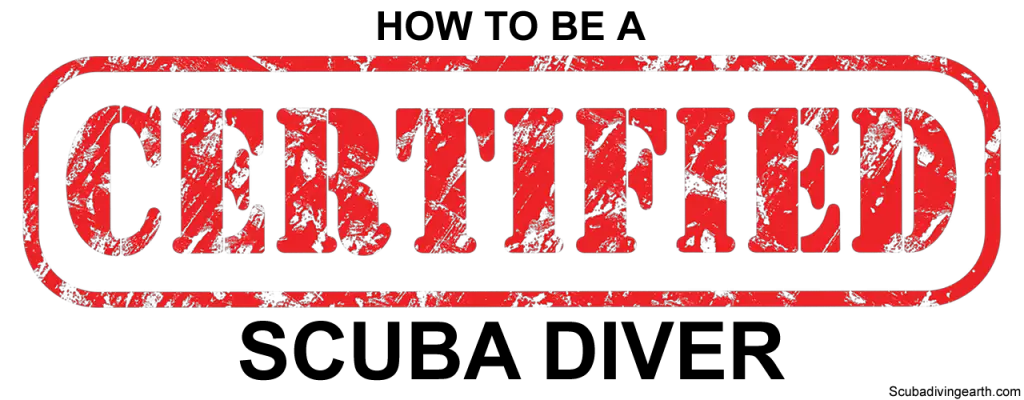
I hope from what you’ve read so far, that you are no longer looking to scuba dive without certification. But instead you are now looking at how to get certified to scuba dive instead.
If not, please jump to the section “Is it dangerous to dive?” In that section of this article, I list a few of the risks and dangers associated with scuba diving.
I wanted to highlight to anyone, but especially those that are considering scuba diving without suitable training and certification, what can go wrong.
Scuba diving is safe if you get trained with a good scuba diving training centre and you follow best practices. For example, plan your dive and dive the plan.
However, for each of the dangers or risks that are highlighted, I also explain how these risks can be prevented too. More to reassure you about how safe diving actually is when approached with the correct attitude. One of the motos we were taught at BSAC is to “plan your dive and dive the plan.”
To get certified to scuba dive you will first need to decide on which one of the diving organisations you wish to train with. In this article, I list nine scuba diving training schools. Which one you choose will partly depend on where you live or where you decide you want your training to be.
In order to get certified to scuba dive, there are four basic elements to learning diving, which include the following sections.
The diver theory exam, which in most cases is learned by eLearning
As with most new skills or hobbies, there are the academics behind it. Scuba diving is no different.
Within the academia part of learning to scuba dive, there’s some important learning to do. In particular the understanding of safety and staying safe when you dive.
With scuba diving you are entering a foreign environment, where you are only able to breath using special equipment. This means you need to have special training on how to use this equipment.
Always keeping in mind when you are learning about scuba diving, that you are entering into a foreign environment. Its an environment that is totally different to the one we are used to living in.
It may seem obvious to say, but as humans, we breath air. When we are underwater, we are in an environment where we are not able to breath air normally. When scuba diving, we can only breath underwater with the aid of suitable diving equipment (an aqualung).
Rules of breathing underwater when scuba diving
However, there are certain rules or principles that affect how we breath air underwater, that need to be understood. We also need to understand about the pressures that water exerts on us, especially the deeper we go. And what this does to our body during the course of the dive.
These are just some of the principles that you’ll learn during this stage of the training process.
Passing the scuba diving theory exam
At the end of this part of the learning process, there’s an exam you have to pass. You’ll need to pass this exam before you’ll be allowed to progress to the next stage of your diver training. It’s important for the instructor to know that you understand all of the basic principles behind diving.
For example, the effects of pressure on your body underwater. Understanding what happens to our bodies and the air we breath when we are in an environment where the pressures are greater than atmospheric pressure. Plus much more. This is about building confidence and about understanding how to be safe under the water.
What diving equipment you’ll need and how it all works
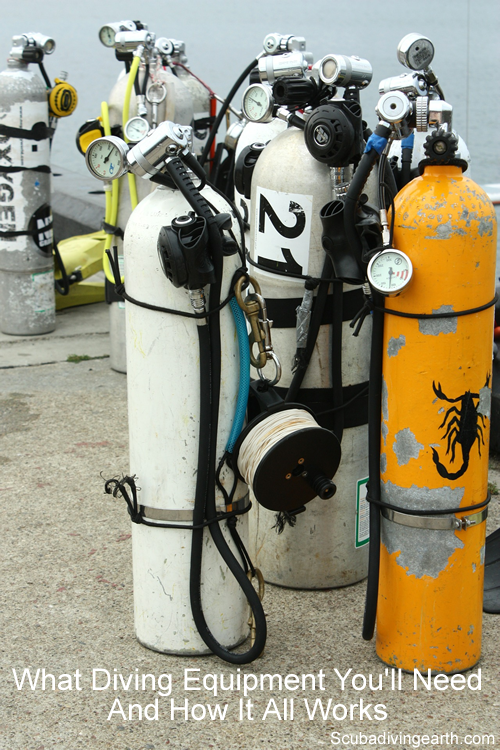
There are some basic equipment needs for scuba diving for all dives.
And then there’s additional equipment you may or may not need for certain types of dive too, like for instance surface marker buoys, delay surface marker buoys, dry suits, wet suits, dive torches, and writing pads are all types of scuba diving equipment that’s nice to have, but not necessarily essential.
More Reading: What is a surface marker buoy used for? (Safety diving equipment)
But like I say, it does depend on the dive you are doing and where that is. For example, if you’re diving in cold waters, a dry-suit then becomes an essential piece of kit. Having said that, there are alternatives to dry suits, which include thicker wet suits or semi-dry suits.
There are also other bits of diving equipment that aren’t essential, but that you’ll possibly buy too. Which may include the likes of dive computers, cameras, underwater video and filming equipment like go-pros, dive watches and more.
However, for the purpose of the initial training, your instructor will take you through the essential equipment.
Your diving instructor will explain the following to you:
- What each piece of equipment is used for and why you need it.
- How you use the equipment safely when you’re under the water.
- How you maintain and clean the equipment after each dive.
- Putting the equipment on before you dive.
- Checking your equipment before a dive (plus how to do a buddy-check of their equipment too).
It’s important to go through this stage of the learning process before you enter the pool. That way, you know how to use the kit once you are under the water. Some of the other stages of this part of the learning process are important also for when you begin to buy your own kit.
The practical scuba diver training in a swimming pool
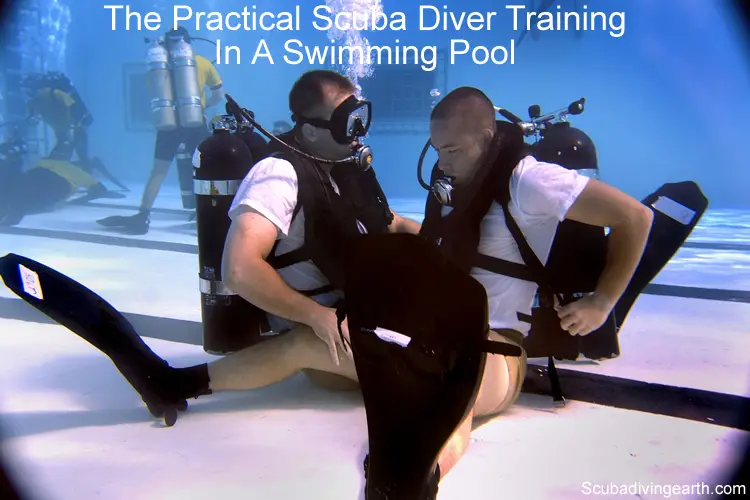
Before you begin your pool training, you’ll need to be able to demonstrate to your diving instructor that you are capable of swimming 200 metres (656 feet) first.
Once your diving instructor is happy about your swimming competence, you can begin to try out and learn how to use the scuba diving equipment on the surface and under the water.
To scuba dive you don’t have to be a fantastic swimmer, but the swimming pool training for scuba diving begins with being able to swim for 200 metres (656 feet). Diving is about being competent in the water and being a confident swimmer.
The reason why this is first done in an enclosed swimming pool is for safety reasons. You’ll begin with learning in the shallow end, so that should you feel anxious or something is not right with whatever you are starting to learn, you’ll be able to stand up in the pool.
The baby-steps of diver training
Diver training is about baby steps. It’s about building confidence and working at each persons own pace. Everyone is different, and everyone learns at a different pace to everyone else.
Also, some people are more nervous than others at the various learning stages of scuba diving. All good diving instructors understand this, and will work with you to help alleviate any fears or to overcome any learning difficulty on any particular exercise that you have.
Before entering the pool, your instructor will run through the basic hand signals too. As another obvious point is, you can’t speak underwater. So communication is done through hand signals.
However, one of my favourite bits of kit is my waterproof writing pad. It’s great to be able to write stuff on this, about what you see under the water or about other things you want to communicate to your dive buddy or to the dive leader if you are in a group.
More Reading: How do I get a dive buddy? (5 easy ways to find a dive buddy)
Mask clearing exercise
One exercise that many students struggle with at this stage in the training, is the mask clearing exercise. But again, this is an important technique to learn and to understand why it’s done.
It essential to overcome any problems you have with achieving your first full mask clear at the pool-training section of your overall diver training.
It’s easier to overcome initial problems with any part of the training in a shallow swimming pool, than it will be to overcome it in open water at deeper depths.
The pool training will usually progress into the deep end of the pool and the instructor will take you through all the practical steps required for this stage of the learning process. Once your instructor is happy with how you’ve progressed with your pool training, you’ll then be able to move on to the open water stage of the training.
The practical scuba diver training in open water
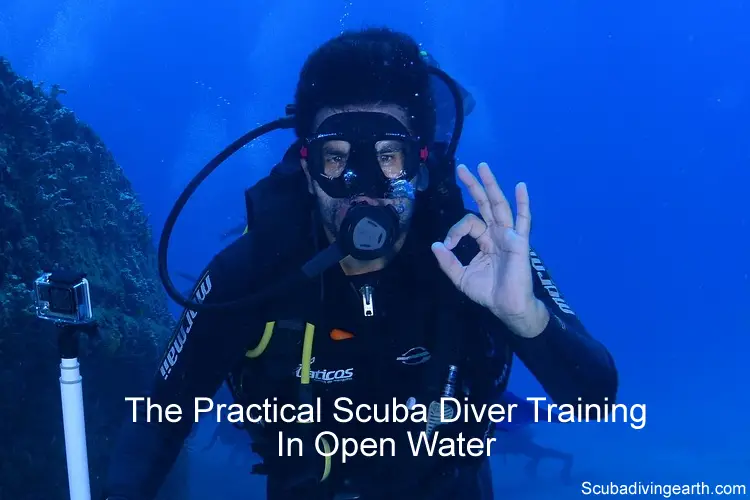
With the BSAC school where I learnt to dive, this part is done in two stages.
The first of these two stages is to progress from the swimming pool to a lake. Then from the lake to the open sea. Whether or not your diver training will involve this extra stage in the learning process, is dependent on where you do your training.
As my scuba diver training was done in the UK, the lake training stage is adopted to provide for a safe ‘still-water’ environment. This is because the waters around the UK have tides and currents, the visibility can be low too. Also, the lake was actually nearer to the training centre than the sea.
Progressing from a swimming pool to the sea
Progressing from the swimming pool to the sea, where there may be tides or currents, or where the visibility may be low, adds more risk to the early learning stages of the diver training process.
These extra factors will not only make it difficult for the instructor, but it will also put the student under added pressure. It’s important for the diver trainee to progress and further learn the skills that they’ve learnt in the pool, without having to cope with other factors like difficulty in seeing their instructor due to poor visibility or having to cope with tidal movements.
If however, you decide to train at a dive centre in let’s say the Caribbean, on for example the beautiful island of Barbados (my favourite of the Caribbean Islands, as it’s where Jo and I got married, so it’s special), then it’s much easier to find ‘still-water’ in the Caribbean seas around Barbados. Which means the lake training step is not needed.
The open water scuba diver training stage is where the real fun begins. This is where your diving journey starts to get exciting. You get to explore and discover new sites and creatures that live in the underwater world.
Either way, once you get to the open water section of the training, this is where the learning gets to be exciting. You get to dive in the sea. Which is what it’s all about.
This is when it really starts to be fun!
Is it dangerous to scuba dive?
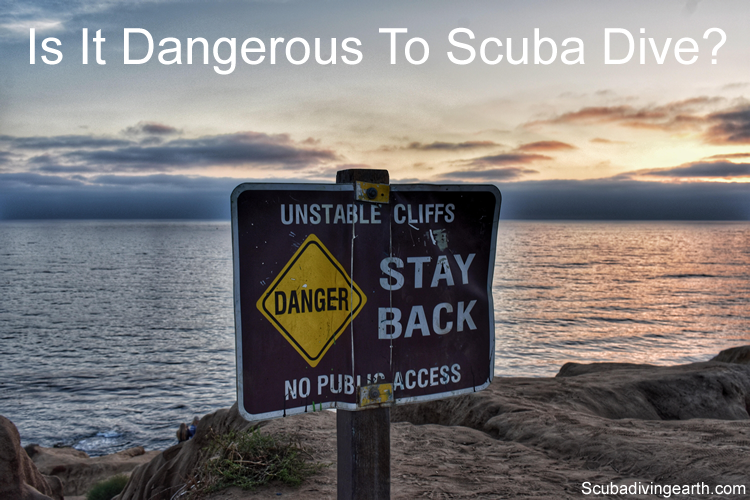
Whilst scuba diving is classed as a dangerous sport, the dangers and risks associated with the sport can be minimised through obtaining a recognised diver certification.
Scuba diving is only dangerous if you dive without a certification or where you dive on you own. Otherwise the risks associated with scuba diving are very small.
However, as already mentioned in the earlier part of this article, I said that I’d run through the dangers of diving. These dangers are addressed in all good diver training organisations and the risks associated with them are very small. Once you’re qualified to dive, you should follow the training you received and never dive alone.
What are the dangers of scuba diving?
I have included some of the more important risk factors associated with scuba diving, which starts with the risks associated with diving alone.
Solo diving or scuba diving on your own is a complete no, no
The first risk to any scuba diver is if they risk diving on their own.
In the diver training circles and within all the leading diver training organisations, solo-diving is a complete no, no! Diving on your own is not only not recommenced, but is actually frowned upon and vehemently discouraged.
The reason why this is so dangerous, is because you are diving in a foreign environment. If your equipment fails, as it can and does do, if you are on your own, your chances of survival are limited.
However, within your diver training, you should be taught how to deal with any of the possible equipment failure situations. These situations are taught in buddy pairs, where if your’s or your buddy’s equipment fails, you are there to rescue one another.
The risks or dangers associated with solo diving are simple to avoid and overcome, by always diving in buddy pairs and by not scuba dive on your own.
Burst lungs or a gas embolisms from holding your breath
You are taught as a part of your diver training not to hold your breath when you are diving. Scuba diving is totally different to surface diving when snorkeling, when you would need to hold your breath. If you hold your breath when you dive, and whilst you are holding your breath you ascend, you risk causing a burst lung or a gas embolism. Both of which could be fatal.
The solution to this danger or risk is very simple. Don’t hold your breath when you dive. Always make sure you are consciously breathing out when you are ascending from your dive. If you do this, it will keep you safe from this risk or danger.
However, one trick to conserve air is to carefully regulate your breathing. This means that you can take in air as a full breath, but instead of breathing out completely like you would do normally when on the surface, you “trickle” breath-out. This means that you slowly release the air from your lungs.
So that whilst the air is in your lungs for that bit longer, they are able to take out as much of the oxygen as possible with each breath that you take. Which in turn, will help to make the air in your dive-tanks last for longer. So your dive will be extended and you can enjoy the underwater world for longer too.
More Reading: What are scuba tanks made out of (Steel vs aluminium scuba tanks)
This technique is different to holding your breath, and if done correctly and is practiced over time, it’s safe to do and will extend the time you take to consume your air and consequently your dive time.
Risk of getting the bends or nitrogen bubbles in your blood or body tissues
One of the most common of risks or dangers is getting the bends. The bends, which is also known as decompression sickness (DCS), is caused by dissolved gases coming out of solution into bubbles inside the body.
DCS can occur if you either ascend from your dive too quickly, or if your length of dive has taken you into decompression stop time, but you surface without taking the required decompression stops.
Both situations can result in getting the bends or decompression sickness. DCS can lead to death in severe cases. So this must be avoided at all costs.
However, the number of times this occurs in diving are extremely low, considering the number of dives that are done each day around the world, so the chances of this happening to you are minimal.
However, this low risk of occurrence is based upon the assumption that you have a diver certification, and that you follow the diver training you’ve been taught.
When decompression sickness can occur
The only real time that decompression sickness happens amongst divers, is when experienced ‘deep-divers’ i.e over 30 metres (98 feet) and many times with dives in excess of 50 metres (164 feet), where the divers are doing mixed-gas diving.
What can happen with this type of diving, is either a diver error or equipment failure happens at depth. And despite diving in buddy pairs, sometimes the only solution is for an immediate surface.
But of course, due to the depth of the dive, there will have been a build up of nitrogen in the body tissues, and with a rapid ascent, without the necessary safety stops, the dissolved nitrogen will form bubbles in the body.
The worst case scenarios where this happens, is when these nitrogen bubbles either get into the blood stream and find their way to the heart, which can cause a heart attack. Or if they find their way into the spinal cord, which can cause paralysis.
If decompression sickness does occur, the first medical solution is to give immediate oxygen to the casualty. Whilst oxygen is being administered, the casualty needs to be to rushed a barometric chamber.
A barometric chamber is a chamber that will take the diver who has DCS back to the same pressure he was experiencing during his dive, plus a bit more.
This renewed pressure will to reduce the bubbles of nitrogen back to a dissolved state in the body tissues. Then the pressure inside the barometric chamber is slowly reduced, to decompress the diver back to normal atmospheric pressure.
This is quite a detailed explanation of decompression sickness for someone who is either new to scuba diving or just about to learn to scuba dive.
As already mentioned earlier in this article, my reason for highlighting these dangers and explaining what they are, is to discourage anyone from diving without certification. And not to discouraging anyone from learning to dive.
So where you intend to train with anyone of the diver training schools mentioned in this article, you don’t have to worry about decompression sickness, as you will taught how to dive safely and how to avoid this happening.
The best ways to avoid decompression sickness are as follows:
- Don’t dive too deep. I rarely dive deeper than 30 metres (98 feet) these days. That’s not to say you can’t dive deeper, but the deeper you dive, so the risk increases.
- Dive using a dive computer.
- Always do the prescribed safely stops. Even if your dive computer doesn’t show a safety stop, always stop at 6 metres (20 feet) for at least three minutes. Which is an added safety precaution.
- Always ascend at the rate prescribed in the training you receive.
- Always dive with a buddy, i.e. in pairs or more.
- Follow best safe diving practices. at all times.
Running out of air is another risk in diving
Of course, if you run out of air underwater, you are in trouble. However, this is something that rarely ever happens. You are trained to always return to the surface with a minimum of 50 BAR or 500 PSI left in your tank.
So by regularly checking your air during the course of your dive, and by planning to return to the surface with the prescribe reserve amount of air in your dive tank, the danger of running out of air is virtually nil.
More Reading: Do empty scuba tanks float? (This depends on the material they are made from)
Newbie divers are more at risk of this occurring, but to avoid this becoming a risk, always dive with someone with more experience than you. Normally, the more experienced diver will take charge and lead the dive, and is supposed to ask for air checks during the course of the dive.
Get used to checking your own air and each other’s air, i.e. buddy to buddy air checks.
Also, when you dive with any good diving school, the dive leader will always check the air of everyone on the dive, by signalling to each diver for them to show how much air they have left.
Equipment failure is a risk to scuba divers
Equipment failure can and does happen. I have been on two dives where the air apparatus has failed, once was in the UK and the other was in Bonaire. On both occasions, I followed the training I have been taught and on both occasions all was well.
One way to avoid the risks associated with equipment failure, is to have your kit regularly serviced. In particular your diving regulators. If these are serviced properly and are replaced if they too old, then they are less likely to fail on the dive.
Also, regularly carry out visual inspections of your equipment, as it’s possible for hoses to burst.
This is what happened on the first occasion I experienced the consequences of equipment failure, which was in the UK. On this occasion, my buddies first stage on his regulator burst, but because I was close-by and because I was suitably trained, we came to the surface calmly and safely, with him breathing from my spare air breathing apparatus.
On that point, the second way to minimise this risk where equipment does fail on a dive, is to always dive in pairs. Always dive with a buddy and never stray too far apart. Always keep within visual sight of each other for the whole of the dive.
The risk of becoming separated on your dive
It is possible to become separate on a dive, despite your best efforts not to lose sight of your buddy. This can happen when you are on a drift dive and there’s a current running.
Where there’s a current, it’s very easy to move apart from your dive buddy very quickly. All it takes is for your buddy or you to stop to look at something on the sea bed, but for your buddy to continue drifting, and before you know it, you’ve lost sight.
More Reading: What should you and your buddy do if separated during a dive?
The other time when getting separate is likely to occur is in low visibility diving. In low visibility situations, it’s extremely hard to keep sight of your buddy,and sometimes before you know it you’ve lost sight.
To minimise these risks, when you are in either of the above scenarios, firstly, make sure you check the position of your buddy more often during the dive.
But if you do split up and you lose sight of your buddy, simply follow the procedures explained in your diver training. Which is to spend a few moments checking nearby and circling to see if you can find your buddy.
If you don’t find them within a a few moments,you should surface immediately. Buy by being careful to follow the correct ascent rates and safely stops on your way to the surface.
Risk of scuba divers being attacked by sharks or other sea creatures
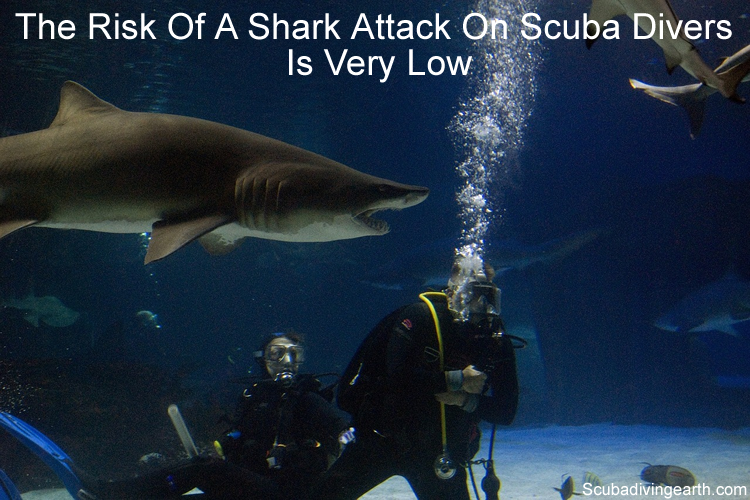
There’s a slight risk of being attacked as a scuba diver, as there have been instances of this occurring. However, you are probably more likely to be knocked over by a bus than to be attacked by a shark or other sea creature.
For example, I love diving with sharks, they fascinate me. But in all the times that I’ve dived with sharks, this has never been a problem.
The risk of attack might depend on the type of shark in question, but with all the sharks that I’ve dive amongst, I have never experienced any problems.
However, diving in and around Great White Sharks is perhaps more of a risk, as Great Whites are extremely curious and bold creatures. So a note of caution, if you decide to dive in the vicinity of Great White Sharks, be very careful. However, most other sharks are actual very timid and shy creatures.
Often times, when I’ve dived in the Red sea for example, at the start of the dive when we descend, there may be sharks around us, but within a very short space of time, the sharks have disappeared from sight to get away from all the divers in the water. Of course this isn’t always the case, but mostly sharks tend to keep their distance.
Although, this too isn’t always the case either, as a dive I did in the Bahamas, there were plenty of reef sharks on the dives I did, and these sharks came very close indeed.
Always remember to respect sharks to avoid the risk of attack
Any risks associate with shark attacks would be heightened where you ‘abuse’ your status in their underwater world. Always remember that you are the visitor, keep a healthy distance from any sharks and certainly don’t harass them. If you do, then you are risking an attack.
There are other sea creatures that can attack you, for example, it’s been known for moray eels to attack divers before. But again, always keep a healthy distance from these creatures and never put your hands or face too close to them.
If you do, they are likely to attack you through self defense. Once gain, I have dived with moray eels on many occasions, which includes the giant morays, without incident. So whilst there’s a slight risk of attack from these types of creature, it’s very unlikely to happen.
What are the different types of scuba diving certifications?
There are many diving schools where you’ll be able to get your diver certification.
Which one you choose will partly depend on where you live. But also it will depend on where you like to spend your time on holiday. Also, where you’d like to do your diving and what type of diving interests you have, may also influence where you learn to dive too.
There are three top scuba diving organisations to choose from with a good international recognition. With PADI being the top most when it comes to the number of training and dive centres around the world. Boasting more than 6,400 dive centres to choose from.
Top scuba diving organisation to get scuba certified
The three top scuba diving certifications in the world, of which I have personal experience with the first two. These are the British Sub Aqua Club (BSAC), Professional Association of Diving Instructors (PADI) and Scuba Schools International (SSI).
I trained and received my certification with BSAC and I’ve dived hundreds of times with PADI shops and schools around the world.
Why I chose BSAC was because it was easier for me to get my diver certification with them, as I live in the UK. It was easy to find a BSAC club near to where I lived at the time, despite not living near to the sea.
However, my daughter learnt to dive in Cyprus with a PADI instructor, but who was also trained as a BSAC diver too, before he set up his PADI dive shop. It was me that chose the location and the instructor, after ‘interviewing’ him on the telephone first. This was my daughter don’t forget!
Who are the other leading dive training organisations in the world?
Having introduced BSCA, PADI and SSI, I want to also to provide a short list of some of the other diving organisations around the world too. There are nine diving organisations that I’ve chosen to list, which are all reputable and that will give you a good diving qualification too.
Here are the nine reputable diving organisations around the world:
- PADI – Professional Association of Diving Instructors (US Based, with the most international training and dive centres of all diving organisations in the world).
- BSAC – British Sub Aqua Club (UK based, world renowned and recognised, but with limited international training facilities)
- SSI – Scuba Schools International (German based, with good international training and dive centres, only second to PADI in terms of training sites world-wide).
- NAUI – National Association of Underwater Instructors (US Based, with limited international training facilities)
- CMAS – Confederation Mondiale des Activites Subaquatiques (Italian/France based, with limited international training facilities)
- SEI – Scuba Educators International (US based, mostly US based training centres)
- SDI – Scuba Diving International (US based, with a fair international representation of training)
- NASE – The National Acedemy of Scuba Educators (US based, limited international training facilities)
- PDA – Professional Diving Academy (UK based, for commercial diver training and specifically based in Scotland)
There are many more scuba diving organisations than are on this list. And if you are interested in finding out more, here’s a link to Wikipedia and the list of diver certification organisations.
Here’s a bit more detail about the top two scuba diving organisations, PADI and BSAC.
Professional Association of Diving Instructors or PADI scuba diving certification
The first is the best known and the most widely available diving qualification around the world. This is the Professional Association of Diving Instructors or (PADI). The PADI certification is well recognised around the world.
However, this organisation does have its critics, but the sheer number of sites around the world shows how popular this organisation is. So critics or not, when you begin to dive the world, whether you train with PADI or not, you’ll end up diving with mostly PADI dive centres around the world.
It’s a great qualification and the instruction you receive is good. It will allow you to dive mostly anywhere you like, as it’s a top diving qualification. You’re likely to see PADI shops and schools in all of the most popular holiday destinations or resorts around the world.
PADI – more details
PADI claim to be the world’s leading scuba diving training organisation. Their registered trade mark is “The Way the World Learns to Dive.”
PADI have over 6,400 diving centres around the world, which is an incredible number. The sheer number of diving schools that are available around the world is what makes using PADI the best option for most to learn diving.
With all of the countries that I’ve dived around the world, most if not all been with PADI dive shops/schools.
The number of PADI trained divers with the PADI certification around the world is in excess of 25 million.
A video with Drew Richardson, president and CEO of PADI…
The underwater world is earth’s final frontier. Drew Richardson, PADI President and CEO shares his passion for diving and talks about the important role of divers as underwater ambassadors and custodians of our ocean planet.
British Sub Aqua Club or BSCA scuba diving qualification
The second top diving school to safely learn diving with, but with more limited access to diver training world-wide is the British Sub Aqua Club or (BSAC).
The qualification gained through BSAC always stands out around the world as a top qualification. All dive centres recognise BSAC training as one of the best in the world.
Whenever I show my certificate, I always get a big thumbs up. Many times, I get put to the top of the list of the divers in a group of all divers. For example, in South Africa, the dive leader asked me to take care of one of the least qualified and more nervous divers in the group. This was after I told him I was BSAC trained.
In Australia when diving on the Nigaloo Reef, the dive leader allowed another BSAC diver and myself to dive on our own away from the main group. He had that much trust in our experience and ability, which he didn’t have with the rest of the group. The rest of the group included PADI trained divers, with himself PADI trained too.
Why is BSAC training so well renowned?
One of the reasons why the BSAC qualification is so renowned and is excellent training to do, is not just because of the training itself, but because of where the training is done.
Most of my training dives were done in UK waters, which can be tricky to dive. The waters are cold, there are tides and currents to deal with and many times the visibility is very limited.
So after having qualified and gain experience in UK waters with BSAC, when you dive in locations where the water is warm, which means you have less equipment to worry about (i.e. no dry suit, which in itself requires special training), the water is usually crystal clear, and there are less tides and currents to worry about, diving in these conditions is a breeze in comparison.
BSAC – more details
So with BSAC you are in safe hands. But unlike PADI, which is a business for profit, the British Sub Aqua Club is a non-profit charitable organisation.
The president of BSCA is HRH The Duke of Cambridge. HRH followed in his grandfathers footsteps to become the president, and like him, HRH also trained to become a diver with BSCA.
A quote from HRH The Duke of Cambridge on the BSAC website:
“Just like my grandfather and my father, I am proud to say that I learnt to dive with BSAC, and share your passion for the sport and the underwater world. “I hope that one day my son, George, will also experience the wonders that snorkelling and scuba diving have to offer.” “The underwater world truly captures the imagination and broadens horizons.”
He also says: “With BSCA you can safely enjoy the most thrilling, challenging and rewarding diving you are ever likely to do.”
A video of HRH The Duke of Cambridge learning to dive in a pool with BSCA chairman Eugene Farrell.
BSCA membership was first started in 1954 and it’s membership peaked at around 50,000 in the mid 1990’s. However, now their membership is around 30,000 strong.
To discover whether there’s a BSCA training school near where you live, please visit their find a club or centre page.
How long does it take to learn how to scuba dive?
Learning to scuba dive doesn’t take very long at all. The length of time it takes to complete the theory side of learning how to scuba dive is partly dependent on you. It’s affected by how quickly you can read, learn and digest the information in the scuba diving manuals. It’s also down to how much time you’re able to dedicate to the training at a time.
The best way to learn is to sometimes do this whilst you are on holiday, so that you are able to devote the time to the training.
Having said that, it’s probably advisable to do the academic side and he associated exam before you depart for your holiday. This stops you having to sit reading books and doing exams whilst you are away on holiday.
However, you can always read the books whilst you are lying on the beach sun bathing, if that’s what you enjoy doing.
Once, you’ve learned the information in the diving manuals and taken and passed the theory exam, the pool training and open water dives can be completed in three to four days. But remember, the opening water diving element of the training is where the fun starts.
This is when the real enjoyment begins and where you start to explore the underwater world and start to build your diving experience.
What you need to consider when choosing your scuba diving certification?
When you choose which diver qualification to go for, there are a few top considerations to think about first. These include:
- Review their training procedures and safety record. Safety is the number one priority with scuba diving.
- Will the qualification be recognised around the world in all dive centres and on diving boats? If you intend to dive around the world, you need to hold a world-wide recognised certification to be able to dive with any diving centres around the world.
- Decide on where you want to train. Do you have a dive centre near to where you live? Would you want to learn and/or dive near to where you live? Do you live where the waters are cold, like for example in the UK? Or would you prefer to learn to dive in warm blue waters of the tropics?
For all of the above considerations, the top three diving organisations, PADI, BSAC and SSI all meet the above criteria. However, when you make your final decision, the organisation you choose out of these three, the decision you make will come down to which one is nearby to where you want to learn diving.
The type of diving you plan to do will influence where you should learn to dive
Where you plan to dive, and the type of dives you are planning to do, should influence where you get your diver training.
For example, if you only plan to dive in what’s referred to as ‘blue waters,’ which is in places like the Caribbean, The Red Sea, Florida Keys, the tropical parts of Australia and so on, then there’s nothing wrong with learning to dive in one of these places too.
However, if you plan to dive in the turbid waters around the likes of the UK, you are better off learning to dive in the UK too. It’s much easier to transfer your skills and experience downwards, i.e. from more challenging diving to easier diving, than it is the other way around.
If you’ve only ever experienced dives in tropical places, where the waters a warm and clear, it wouldn’t be good to jump straight into the cold and murky waters of the UK. However, if you’ve learnt to dive in the UK, then diving in ‘blue waters’ is extremely easy in comparison.
Do you need a license to snorkel?
The risks associated with snorkeling are far less than they are with diving. Which is why you don’t require a license to snorkel.
However, you still need to be careful when you are snorkeling, especially when snorkeling near to rocks when there’s a swell. You must also watch out for tides or currents in and around the coastal regions.
Most of the diving schools mentioned in this article will not only teach you scuba diving, but they’ll also teach you how to snorkeling too. So whilst you can teach yourself how to snorkel, and although you don’t need a license or certification to do it, it might pay you to learn to snorkel with one of the dive schools, so you do it safely.
What is the cost of diver certification?
The cost of your diver certification is dependent on which diver training school you learn through.
The best approach to this I recommend is that you re-read the section on “The type of diving you plan to do will influence where you should learn to dive,” as it’s more important to train where you’ll enjoy the training.
But also to train for the type of diving you think you’ll enjoy, than to base it off of the cost of the training itself.
Most of the costs associate with the training will be similar from organisation to organisation. But you are more likely to be able to train with a PADI diving centre than any other of the organisations, simply due to the number of diving locations and dive shops that PADI have around the world.
I hope you enjoyed this article about scuba diving certification…
I’d love to hear from you. Tell us about your adventures of diving and snorkeling, in the comments below. Please also share your photos. Either from your underwater cameras or videos from your waterproof go-pro’s!
If this article hasn’t answered all of your questions. If you have more questions either about snorkeling or scuba diving (or specifically on diver certification), please comment below with your questions.
There will also be many more articles about scuba diving (and on snorkeling) for you to read and learn about this fabulous sport.
Have fun and be safe!

